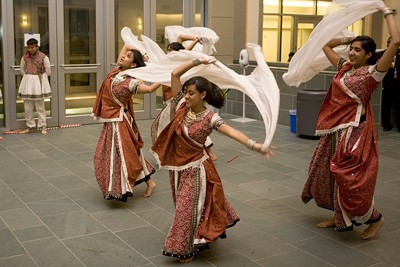Student group travels to India for cultural experience
By Daniel Aloi
Twelve students in the Minority Organization of Architecture, Art and Planning (MOAAP) are on a winter break trip to India Dec. 31-Jan. 21, engaging in cultural immersion and field study at several sites in rural areas and cities from Delhi to Mumbai.
The trip is a student-led initiative, and participants will tour "everything from the traditional housing in Mumbai to a bird sanctuary in Rajasthan and the Taj Mahal," said city and regional planning associate professor Jeffrey Chusid, who is accompanying the group. "We'll be meeting with planning professionals, architects and artists, as well as doing some essential sightseeing related to the culture and the history of the place, and [having] experiences from food to Bollywood movies."
Students will conduct an academic design exercise in Diggi, a rural community 50 miles south of Jaipur.
"It's a community with a 1,000-year-old fort and a Hindu temple which attracts some 100,000 visitors or pilgrims a year," Chusid said. "In this town of 5,000, there was a question of how best to plan for both of those, and also to understand and plan for what the community needs itself."
ILR School student Ray Mensah '11 said before the trip that he would be looking "into the construction laws and the labor laws in India, so we can have that background as we prepare to draw up our plans."
The group will study water, transportation and planning issues in Delhi, and will observe how the city is preparing to host the Commonwealth Games later this year. They will also tour Mumbai slums and factories. In addition to visiting museums, art students have arranged to meet with professional photographers working in India. "We'll be going to historic sites that have native, historical art and architecture of India," Chusid said.
The trip involves 10 students from the College of Architecture, Art and Planning and one each from the ILR School and the College of Engineering. MOAAP membership is open to all Cornell students.
The organization approached Chusid and city and regional planning professor Michael Tomlan to help them structure the trip. MOAAP raised funds throughout the fall semester and held an Indian-themed gala Nov. 20 in the Duffield Hall Atrium.
"We raised funds, but more importantly we raised awareness of our service-learning initiative to a wide and varied audience," said MOAAP treasurer Fernando Montejo '10.
The students will assemble an exhibition from the trip to be mounted on campus in the spring and will prepare a formal presentation on the design exercise in Diggi.
"You do a lot of sketching, a lot of photography, a lot of interviews and take a lot of notes while in the field," Chusid said.
Chusid and Tomlan have done extensive research in India. Chusid focuses on "urban transformation issues -- the fate of post-independence modern architecture and planning and what was done basically after Nehru to transform India," he said. He is studying the preservation and history of these sites including the work of Joseph Stein, an American architect who arrived in India in 1952 and worked there until his death in 2001.
"India in the past few years has been changing incredibly rapidly, and we'll see that," Chusid said. "The contrasts and the contradictions of the country are very powerful."
Media Contact
Get Cornell news delivered right to your inbox.
Subscribe